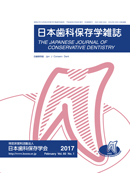
- Issue 6 Pages 267-
- Issue 5 Pages 229-
- Issue 4 Pages 191-
- Issue 3 Pages 111-
- Issue 2 Pages 69-
- Issue 1 Pages 1-
- |<
- <
- 1
- >
- >|
-
IGARASHI Masaru, KITAJIMA Kayoko2017 Volume 60 Issue 4 Pages 191-196
Published: 2017
Released on J-STAGE: August 31, 2017
JOURNAL FREE ACCESSDownload PDF (1535K)
-
KOBAYASHI Tetsuo2017 Volume 60 Issue 4 Pages 197-199
Published: 2017
Released on J-STAGE: August 31, 2017
JOURNAL FREE ACCESSDownload PDF (159K)
-
TOMOKIYO Atsushi, HAMANO Sayuri, HASEGAWA Daigaku, SUGII Hideki, YOSHI ...2017 Volume 60 Issue 4 Pages 200-210
Published: 2017
Released on J-STAGE: August 31, 2017
JOURNAL FREE ACCESSPurpose: Tooth color change is sometimes caused by discoloration of white mineral trioxide aggregate (WMTA) used for direct pulp capping and perforation repair. However, a few studies have performed detailed analyses regarding its discoloration including color tone and penetration. Therefore, this study aimed to examine the discoloration pattern of WMTA treated with endodontic and restorative treatment-related solutions.
Methods: WMTA powders were mixed with distilled water (DW) in a 3 : 1 powder/liquid ratio. The mixture was placed inside polypropylene molds to form WMTA disks. These disks were treated with DW, sodium hypochlorite solution (NaClO), ethylenediaminetetraacetic acid solution (EDTA), hydrogen peroxide solution (H2O2), bonding agent (BOND), blood (BLOOD), typeⅠ collagen solution (COL1), and iodine solution (JG). After 1, 7, and 14 days, the disks were observed with a stereoscopic microscope and their color was analyzed by a spectrophotometer. Additionally, they were dissected at their center and the dissected surfaces were observed with the stereoscopic microscope. Additionally, bismuth oxide powders were also treated with DW, NaClO, BLOOD, and JG, and they were observed and analyzed similar to WMTA disks. Statistical analysis was carried out on the color values from five randomly chosen points in the images of MTA disks and bismuth oxide powders.
Results: MTA disks treated with DW, EDTA, H2O2, BOND, and COL1 showed the same color as before the treatment; however, disks immersed in NaClO, BLOOD, and JG revealed significant discoloration. While the discoloration was localized on the surface of the disks treated with BLOOD, it had penetrated the disks immersed in NaClO and JG. The discoloration was also observed in bismuth oxide powders treated with NaClO, BLOOD, and JG; however, its pattern was different between WMTA disks and bismuth oxide powders.
Conclusion: WMTA disks and bismuth oxide powders showed discoloration when they were treated with sodium hypochlorite solution, blood, and iodine solution; however, their discoloration pattern and penetrating level were different.
View full abstractDownload PDF (5725K)
-
ANAN Hisashi, MATSUZAKI Etsuko, MATSUMOTO Noriyoshi, HATAKEYAMA Junko, ...2017 Volume 60 Issue 4 Pages 211-218
Published: 2017
Released on J-STAGE: August 31, 2017
JOURNAL FREE ACCESSPurpose: Endodontic-periodontal lesions are often observed in clinical situations. Although endodontic-periodontal lesions are encountered they may pose difficulties for the clinician in diagnosis and complicate the treatment. Diagnosis is often challenging because these diseases have been primarily studied as separate entities, and each primary disease may mimic clinical characteristics of other diseases. Here, we report a case of endodontic-periodontal disease of an immature tooth with a vertical bone defect extending to the root apex in which successful results were obtained by using infected root canal treatment and apexification with Vitapex containing calcium hydroxide.
Case: A 10-year-old girl visited with the chief complaint of gingival swelling of the mandibular left premolar. She was referred to the hospital for specialized care, manifesting spontaneous pain (−), percussion pain (+), tooth mobility (−), and apical pressure pain (±), sinus tract (+) in 35. Probing periodontal pocket depth (PPD) of 35 was 6 mm, with no bleeding on probing; PPD of the other teeth was less than 2 mm. Radiographic examination revealed a prominent radiolucent area extending to the root apex in the mesial site of 35. A radiolucent area in the central portion of the occlusal surface was observed. A gutta-percha cone through the sinus tract was used to close the root apex. The infected root canal treatment and apexification were implemented based on a clinical diagnosis of Class Ⅰ endodontic-periodontal disease (retrograde periodontitis) caused by fracture of the central cusp. After the infected root canal treatment, reduction of radiolucency and bone tissue regeneration were continuously observed at the mesial site of 35. Root canal filling was performed because a remarkable recovery of bone tissues was observed from the apex to the marginal portion and the open apex was closed 9 months after the infected root canal treatment. 2 years and 4 months after the root canal filling, no radiolucent area was observed and the alveolar bone height showed the same level as that of the neighboring teeth. The prognosis has been favorable, with a clear laminar dura at the mesial site of 35.
Conclusion: The results show the importance of accurate examination and diagnosis by clinical examination and precise observation of X-ray films in the treatment of endodontic-periodontal disease (primary endodontic lesion) showing retrograde periodontitis and open apex.
View full abstractDownload PDF (2652K)
- |<
- <
- 1
- >
- >|